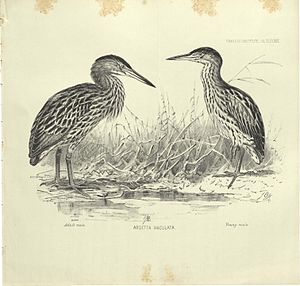Black-backed Little Bittern
| Black-backed Little Bittern | ||||||||||||
|---|---|---|---|---|---|---|---|---|---|---|---|---|

Black-backed Little Bittern (male and young male) |
||||||||||||
| Systematics | ||||||||||||
|
||||||||||||
| Scientific name | ||||||||||||
| Ixobrychus novaezelandiae | ||||||||||||
| ( Purdie , 1871) |
The black-backed bittern ( Ixobrychus novaezelandiae ), called Kaoriki in the Maori language , is an extinct species of bird in the heron family . At times it was considered a subspecies of the little bittern ( Ixobrychus minutus ). Their distribution area included New Zealand and the Chatham Islands .
features
The black-backed bittern is said to have looked very similar to the bittern. She was taller, however, her legs were sturdier and her plumage was more striped and more vividly maroon in color. He was 38 centimeters tall and weighed about 250 grams.
Occurrence
Most of the live specimen observations were on the west coast of New Zealand's South Island , where, among other things, an individual was collected at Lake Wakatipu . On the North Island there was a possible observation from the Tauranga region in 1836 . Otherwise, the black-backed bittern is only known from the North Island through subfossil remains from fossil deposits on Lake Poukawa and from the region of Paekākariki. Other bone material was discovered on the Chatham Islands.
Habitat and way of life
Little is known about their way of life. The researcher Charles Douglas described it as a very shy bird that could hide well in inaccessible swamps. The black-backed little bittern was found in coastal lagoons and on stream banks. The researcher William Docherty noticed that these solitary birds, with their heads stretched upwards, were looking over the water and hovering in one place for hours. This almost upright posture is a camouflage behavior that can also be observed in other species of bittern. The diet consisted of worms and small fish.
die out
The extinction of the black-backed little bittern is thought to be due to the stalking by Pacific rats , brown rats , house rats , polecats , ermines , weasels and feral domestic cats . The bone that was found in a clam pile near Paekākariki is an indication that the black-backed little bittern was also hunted by humans. It was already considered rare before 1860 and probably died out in the 1890s. Today there are 13 preserved specimens, one incomplete skeleton and eight subfossil bones in the Museum of New Zealand Te Papa Tongarewa .
literature
- A. Tennyson and P. Martinson: Extinct birds of New Zealand. Te Papa Press, 2006, ISBN 0-909010-21-8
- Trevor H. Worthy , Richard N. Holdaway: The Lost World of the Moa. Prehistoric Life of New Zealand. Indiana University Press, Bloomington 2002, ISBN 0-253-34034-9 .
- Walter Lawry Buller: Notes on the Little Bittern of New Zealand (Ardetta maculata) . In: A History of the Birds of New Zealand , 1888 PDF full text
Web links
- Holotype from the collection of the Museum of New Zealand Te Papa Tongarewa
- New Zealand Little Bittern / Kaoriki. Ixobrychus novaezelandiae. by Paul Martinson Illustration from Extinct Birds of New Zealand by Alan Tennyson, Te Papa Press, Wellington, 2006
- Ixobrychus novaezelandiae inthe IUCN Red List of Threatened Species 2013.1. Listed by: BirdLife International, 2012. Retrieved October 6, 2013.
Individual evidence
- ^ A b Thomas Henry Potts: On the Birds of New Zealand (Part II) . Transactions and Proceedings of the New Zealand Institute 3: pp. 59-109. ( Online version ), 1871
- ↑ John Pascoe: Mr. Explorer Douglas. AH & AW Reed. Wellington, 1957
Remarks
- ↑ Some sources state that Thomas Henry Potts was the first to describe it. However, the first description was provided by Alexander Callender Purdie, to whom Potts also refers in his description